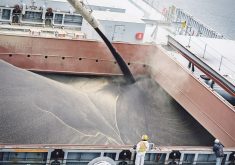What’s normal?
That’s a tough question to answer when it comes to crop price ranges and yearly volatility in the futures markets.
You wouldn’t think it would be that difficult, but volatility and price ranges seem to come in chunks of time, in periods when predictability settles in for a few years, then is swept away without notice. It’s hard enough to establish these things in a normal year. It’s a nightmare in a year after a historical price spike and a continuing worldwide economic and financial crisis.
Read Also

Russian wheat exports start to pick up the pace
Russia has had a slow start for its 2025-26 wheat export program, but the pace is starting to pick up and that is a bearish factor for prices.
That makes it hard for farmers to figure out what price ranges to expect and challenging for analysts to produce predictions that can stand up for a few months.
Recently at Manitoba Ag Days, several market analysts offered their best guesses for crop prices in the next year, with consensus that the ranges will be wider and volatility greater.
But it’s almost a Mission Impossible assignment to predict now what the price ranges and volatility will be for the next few years because we appear to be in a new era.
Because of that, I thought I’d consider what happened after previous price spikes. Rather than rely on forward-looking economic analysis, I’ve crawled through market history to try to produce simple comparisons.
Three price peaks offer differing resolutions, one of which is good for farmers and the other two not good at all.
Almost any farmer would love to relive the 1970s. The happy period began in 1973 when U.S. wheat prices shot up from less than $2 per bushel to more than $6, and then stayed above the market highs of the 1950s and 1960s permanently. The prices were volatile, often ricocheting up and down by 60 percent in a year, but they never dropped to where they had been and most years offered lucrative prices.
It wasn’t so nice after the peaks of 1988 and 1996. Those years had explosive surges, but the plunges in most crops afterward weren’t followed by dramatic recoveries, and producers waited in vain for the kind of bold rallies they experienced in the 1973-82 period.
Following the spike, they got flat markets for years. Analyst Jeffrey Kennedy of Elliott Wave International remembers a period like that: 1998 to early 2002.
“I dreaded coming into the office in those days,” Kennedy told me.
“There was nothing happening.”
Volatility appears to be a dirty word with some farmers and investors these days. I keep hearing people refer to volatility as if it is a disease. That makes sense if you see volatility only when prices are falling fast and you see rising prices as the way things should always be and not a manifestation of the same volatility.
But reasonable farmers should realize crop prices tend to move in a range, and they get the best pricing opportunity when there is the biggest range possible, which means living with the most volatility.
It’s too early to know what the long-term resolution to the peak of 2008 will be. It could be the 1970s, the late 1980s, the late 1990s or something unique.
But whatever becomes the new normal, let’s hope it has lots of volatility. That’s where the money will be made.















